Jharkhand’s music is more than a collection of notes and rhythms; it is a living testament to the deep-rooted connection between music, identity, and community. Every instrument, every stroke, and every rhythm carries the weight of generations, binding the past with the present in a symphony of cultural continuity. It is within this realm of melodic wonder that we embark on a journey to unravel the enigma of Jharkhand’s musical instruments – instruments that produce a burst of emotions, a burst of tradition, and a burst of sonic brilliance.
Table of Contents
Section 1: Sonorous Creations through Friction
Various melodious resonances are coaxed forth from musical instruments via the art of friction. Instruments such as the Kendra, Banam, Buang, Tuila (also referred to as Tohila), Ektara, and the Sarangi, all hailing from diverse cultural tapestries, find their sonorous voices through the act of rubbing and manipulation.
Creating Melodies Through Friction: A Harmonious Exploration of Musical Instruments that Produce Sound by Rubbing
Music, the universal language that transcends boundaries and touches souls, finds its diverse expressions through an array of musical instruments. Among these, a unique group of instruments produces sound not through striking or plucking, but by the intimate act of rubbing. Imagine the sensation of fingertips meeting strings, the vibrations igniting a symphony of emotions. Let’s embark on a harmonious journey into the world of Kendra, Banam, Buang, Tuila, Ektara, and Sarangi, where sound emerges from the embrace of friction.
1.Kendra: The Lyrical Lyre
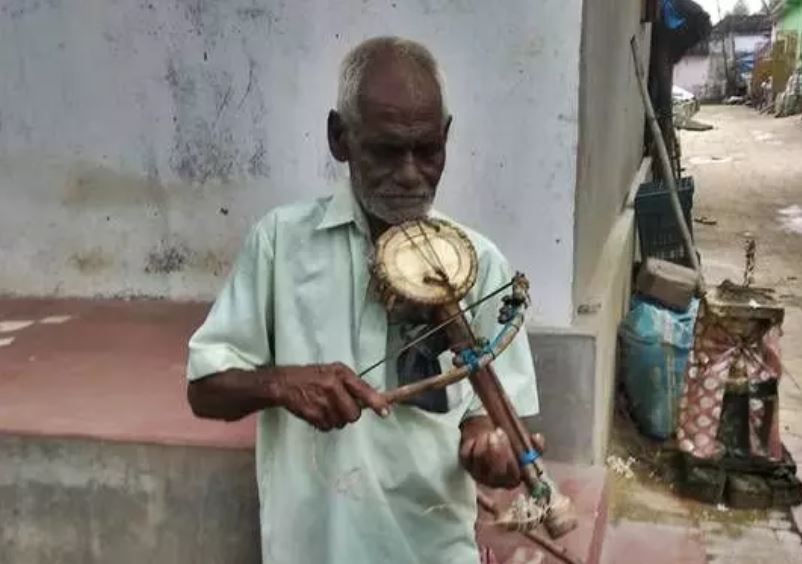
In the heartlands of India, the Kendra resounds with notes that evoke ancient tales. As skilled fingers glide across its strings, the instrument releases mellifluous melodies. The Kendra’s body resonates with the friction between strings and fingertips, creating an intimate connection between musician and music.
It’s as if the stories of generations are whispered through the friction’s embrace.This is popular instrument in chota Nagpur region.
2.Banam: The Bow’s Tale
Picture the hills of Assam, where the Banam, a rustic fiddle, awakens the hills with its songs. The friction of the bow against the strings conjures melodies that speak of tradition and belonging. With each stroke of the bow, the Banam weaves a narrative that echoes through time, capturing the essence of santhal community’s cultural landscape.
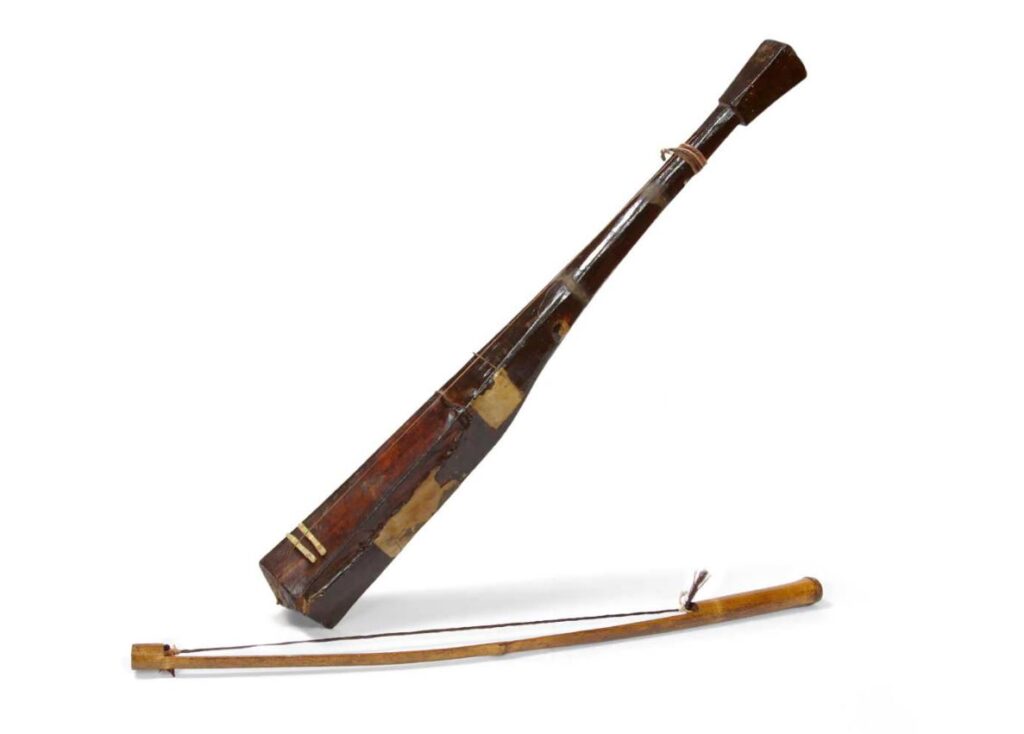
3.Buang: Echoes from the Hills
Santhal community favorite instrument is Buang. This bamboo instrument, shaped like a mouth organ, invites musicians to breathe life into its pipes. As the musician blows and rubs, the Buang resonates with echoes of hills and valleys, evoking a connection between humans and the land they call home.
4.Tuila/Tohila: Whispering Winds
Tuila/Tohila is famous due to its soft sound and do not play with other instrument. This instrument, akin to a jew’s harp, transforms air and touch into ethereal sounds. As the musician rubs the instrument’s reed, the Tuila emits delicate tones reminiscent of winds rustling through the mountains, allowing the player to commune with nature through sound.
5.Ektara: Unplugged Harmony
In the heart of rural India, the Ektara resonates with a burst of simplicity. A single string stretched over a resonator becomes a canvas for storytelling.
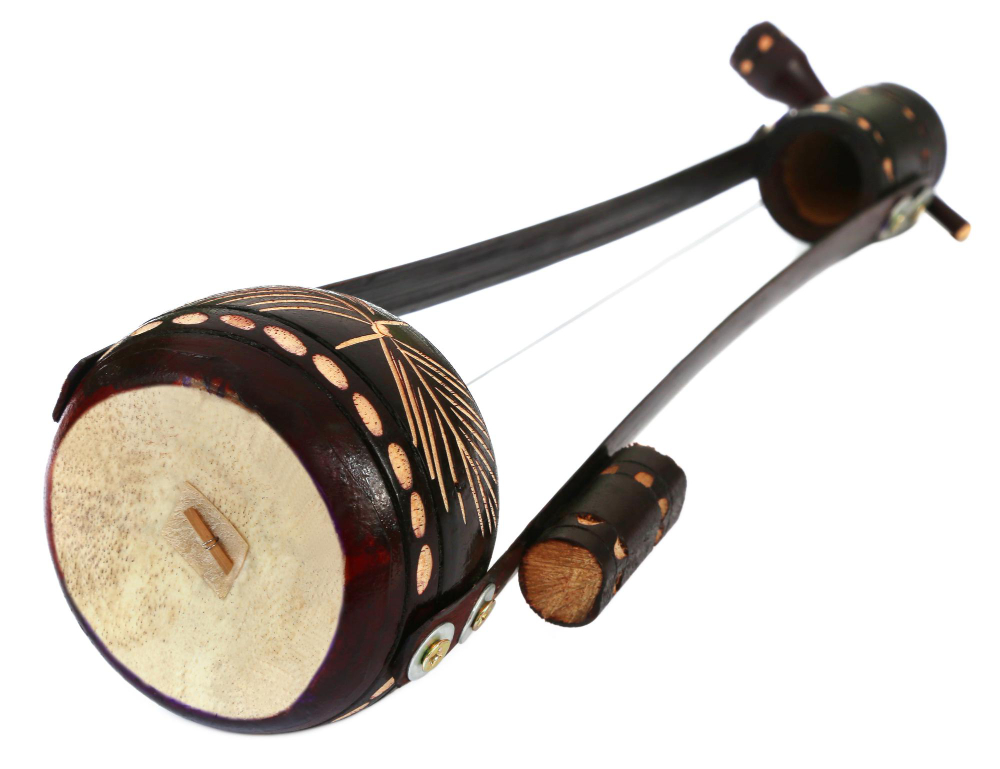
It is mostly used by fakirs, saints and monks in devotional songs. With each gentle rub of a finger, the Ektara weaves raw melodies that capture the essence of human emotions—joy, longing, and the profound human experience.
6.Sarangi: Conversations of Strings
Travel to the heart of classical Indian music, and you’ll find the Sarangi—a treasure trove of intricate sounds. As the musician’s bow rubs against the strings, the Sarangi becomes a vessel for expression. Its complex harmonies and nuances burst forth, each note a brushstroke on a canvas painted by the friction between bow and string.
A Personal Note: The Intimacy of Friction
Imagine sitting with these instruments, feeling their vibrations resonate through your fingertips. The act of rubbing isn’t just a mechanical motion; it’s a tactile conversation with music itself. It’s the warmth of human touch sparking the birth of sound. In a world of technological marvels, these instruments remind us of the intimate relationship between human hands and the music they create.
As we explore the Kendra, Banam, Buang, Tuila, Ektara, and Sarangi, we realize that the friction they embody isn’t just physical—it’s the friction between culture and creativity, between tradition and innovation. It’s the friction that binds generations, as melodies are passed down like cherished heirlooms.
In a symphony of rubbing, these instruments become a metaphor for life—a reminder that even in moments of friction, beauty can emerge. So let us celebrate the instruments that bridge our senses with the world of sound, inviting us to rub against the fabric of music and discover the magic within.
In the Melodic Embrace of Friction: The Symphony of Instruments
In the embrace of friction, these instruments emerge as storytellers, capturing the essence of regions, cultures, and emotions. With every stroke, every touch, they create harmonies that resonate with the depths of our souls. The Kendra, Banam, Buang, Tuila, Ektara, and Sarangi prove that music isn’t just an auditory experience—it’s a tactile journey that invites us to touch the very essence of our humanity.
Section 2: Leather Crafted Harmonics
Another facet of musical craftsmanship is manifested through instruments forged from an assortment of leathern materials. The Mandar, Nagara, Dhol, and Dhak epitomize this category. Each of these instruments, with their unique timbres, resonates through their leather-infused constitution.
Unveiling the Melodic Mirage: Exploring the Sonic Magic of Leather-Made Musical Instruments
In the enchanting world of music, a captivating array of instruments awaits, each possessing a unique charm that resonates with the soul. Among these, a distinct subset stands out—musical instruments crafted from various types of leathers. These instruments, like the pages of a musical manuscript, unfold their melodies through intricate interactions with leather. Imagine the myriad textures and tones that emerge as skilled hands strike, pluck, or beat against the supple surface. Let’s embark on an audial adventure into the realm of Mandar, Nagara, Dhol, and Dhak—where leather becomes a canvas for melodies that burst forth with life.
1.Mandar: Resonance of Tradition
The Mandar is a folk musical instrument of Jharkhand. It is very popular and widely used as hand drum in Jharkhand.
The Mandar reigns supreme as a percussion instrument with deep cultural roots. Its circular frame, adorned with stretched leather, becomes a resonating chamber for rhythms that connect generations. As skilled hands strike the Mandar’s leather surface, it releases percussive bursts that echo through time—a tapestry of tradition woven through leather’s embrace.
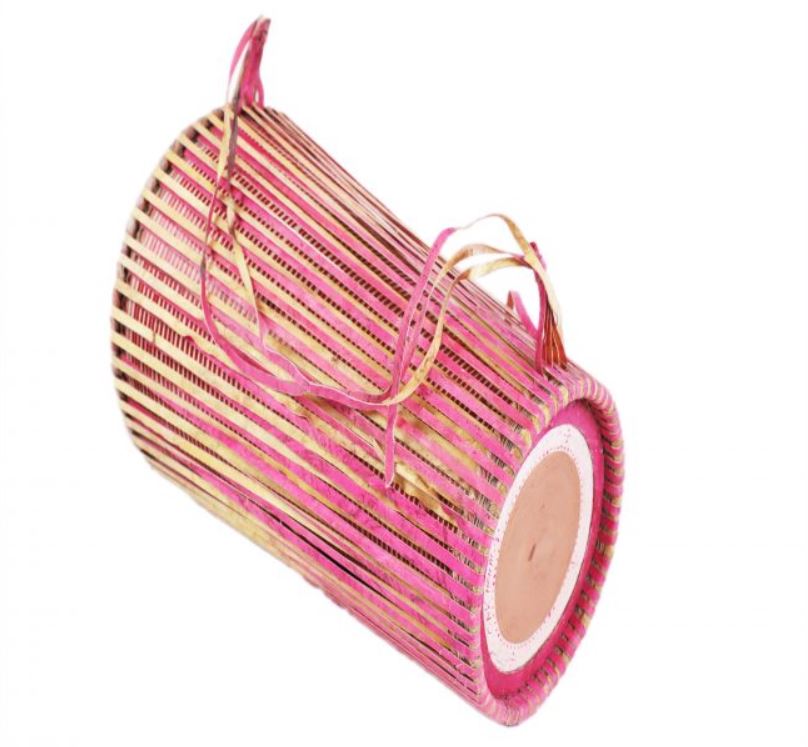
2.Nagara: Drumming Dialogues
Nagara is main musical instruments of Jharkhand. Small version of nagara is called ‘Tamak’ in Santhal Pargana region.
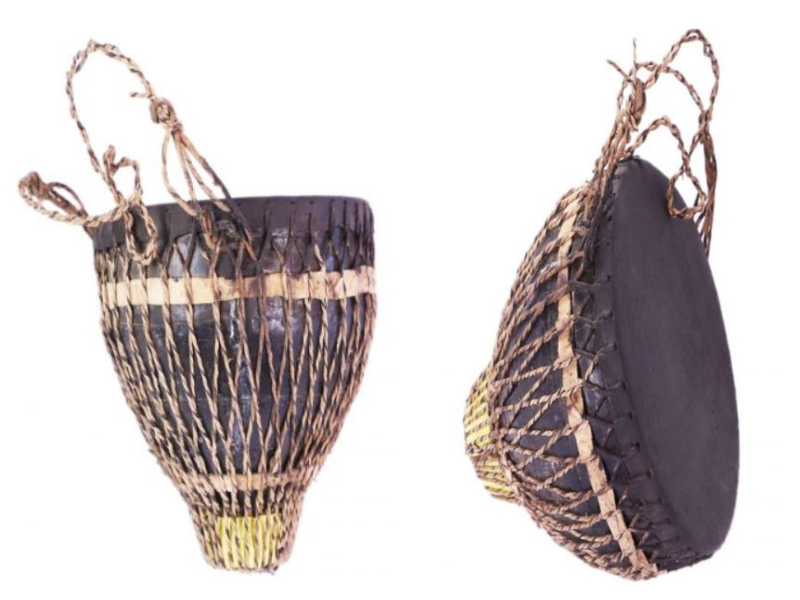
Crafted from leather and metal, this double-headed drum becomes a medium for conversations in rhythm. The interaction between hands and leather becomes a burst of dialogue—a sonic exchange that speaks of festivities, celebrations, and the pulse of life.
3.Dhol: Beats of Unity
Dhol is playing almost every festival of Jharkhand marriage, festivals and worship events. In the northern plains of India, the Dhol stands tall as a symbol of unity and energy.
Its cylindrical body made of jackfruit or mango tree, dressed in leather, houses a vibrant heartbeat. As hands wield sticks against the Dhol’s surface, the leather becomes a catalyst for infectious beats that bridge cultures, inviting people to dance to its dynamic bursts.
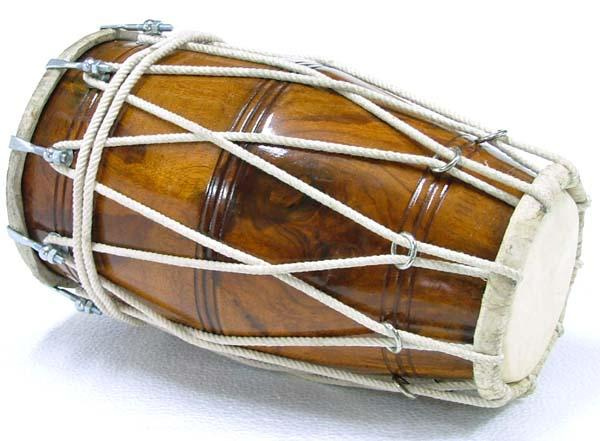
4.Dhak: Echoes of Festivity
Dhak is main musical instrument during Durga-puja, Mansa Puja. This you can find in West Bengal in every festive the Dhak—a powerful drum that resonates with festivities.
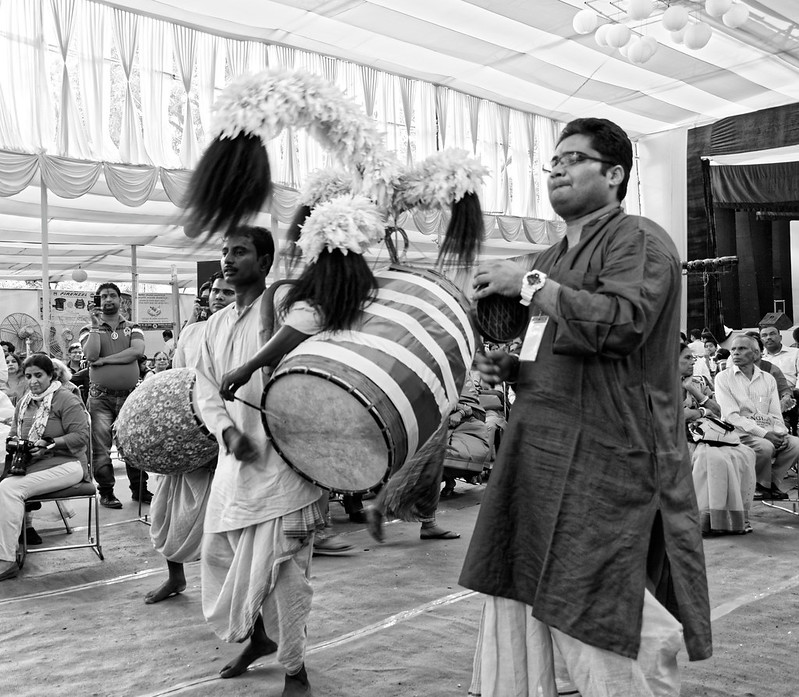
Wrapped in leather, the Dhak produces thunderous beats that mark joyous occasions. The interplay between hands and leather surface becomes a burst of energy, capturing the essence of celebrations that pulse through the air.
A Personal Note: The Melodic Touch of Leather
Imagine running your fingers across the leather-clad surface of these instruments. Feel the texture beneath your fingertips—an intricate mosaic of softness and resilience. As hands engage with leather, they create bursts of sound that transcend the material’s physicality, weaving a narrative that resonates deep within.
The act of striking leather isn’t just about producing sound; it’s a tactile dialogue—a conversation between musician and material. Leather becomes a conduit for expression, a medium that bursts forth with emotions that words alone cannot convey. It’s the embodiment of the unspoken language of music that transcends barriers.
As we explore Mandar, Nagara, Dhol, and Dhak, we realize that these instruments encompass more than just music. They’re an embodiment of heritage, culture, and human connection—a testament to the ways in which artistic expression is woven into the very fabric of societies.
Harmony in Leather: Crafting Musical Expressions
Within the layers of leather, Mandar, Nagara, Dhol, and Dhak come to life as storytellers, narrating the tales of regions, traditions, and celebrations. With every strike, every beat, they create harmonies that resonate deep within the human experience. These instruments aren’t just objects; they’re vessels that carry emotions, history, and the shared human journey.
The Mandar’s percussive bursts, the Nagara’s rhythmic dialogues, the Dhol’s unified beats, and the Dhak’s festive echoes—all these showcase the artistry that springs forth from leather’s touch. Together, they form a symphony that speaks to the profound connection between creativity and materiality.
In a world filled with intricate melodies, these leather-made instruments remind us of the tactile beauty that music can bring. They invite us to engage our senses, to feel the pulse of history, and to embrace the bursts of emotions that emerge when hands and leather unite in a harmonious dance.
Section 3: Harmonious Tunes via Oral Gustation
A distinct subset of musical instruments derives their mellifluous cadences from the mastery of mouth-blown maneuvers. Included in this category are the Bansuri (also known as the Flute), Murali, Kenndri, SInga, Dhamsa, Thala, Shehnai, and the Madanbheri. Each of these instruments requires adept oral exhalation for their harmonious renditions.
A Harmonic Overture: Exploring the Enchanting World of Mouth-Blown Musical Instruments
In the vast realm of musical expression, an intriguing collection of instruments beckons us with their soul-stirring melodies. These instruments, unlike those struck or plucked, rely on the intricate art of mouth-blowing to conjure symphonies that transcend time and culture. Imagine the breath of life channeling through these instruments, igniting a burst of melodies that resonate with our hearts. Let’s embark on a melodious journey into the world of Bansuri, Murali, Kenndri, Singa, Dhamsa, Thala, Shehnai, and Madanbheri—where every note is a burst of life created by the embrace of breath.
1.Bansuri: The Whispers of Wind
In the heart of India, the Bansuri—often referred to as a flute—breathes life into notes that seem to dance on air.
In Jharkhand Bansuri is very popular musical instrument. Most of Sadari song start with Bansuri sound. Shephered often can be seen with Cow, Bull, Goat grazing with playing Bansuri. As breath flows through the delicate holes, it produces ethereal melodies that resonate with nature’s whisper.
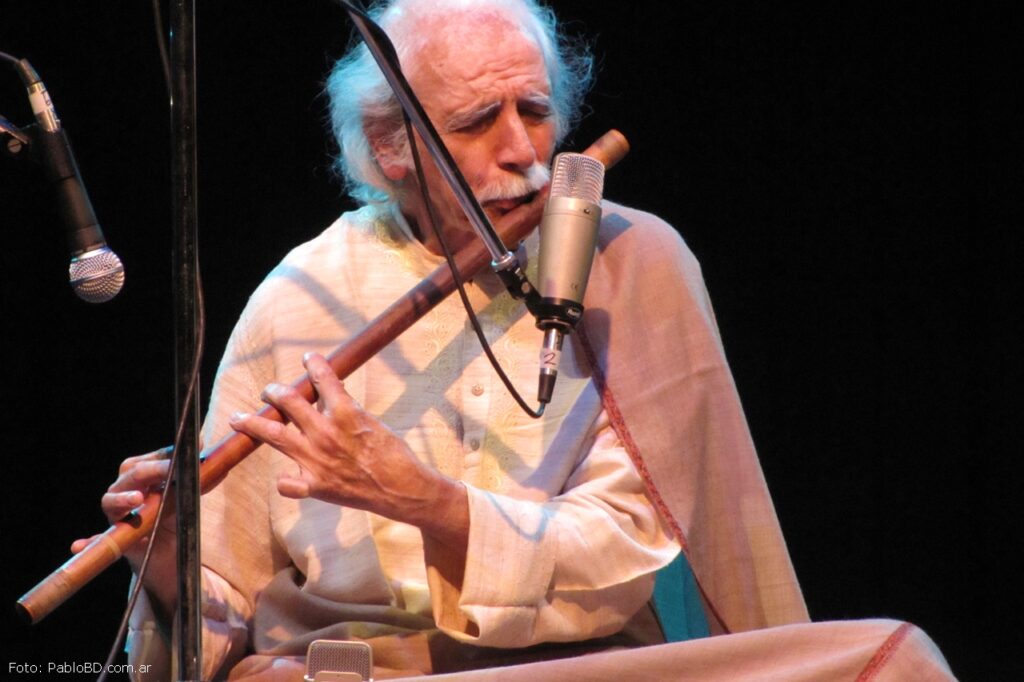
The Bansuri isn’t just an instrument; it’s a conduit between the musician’s breath and the universe’s song—a connection that’s as profound as it is ephemeral.
2.Murali: Tales from the Hills
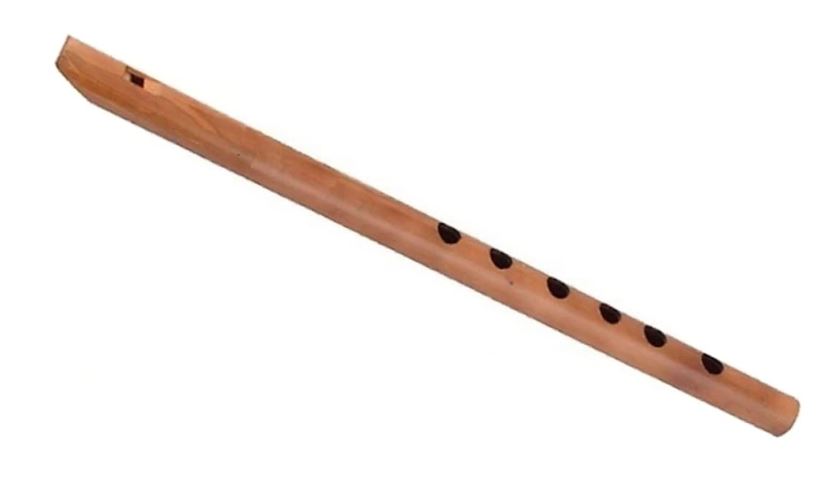
Travel to the hills of eastern India, and the Murali serenades the senses with its mystic charm. This bamboo flute’s haunting notes evoke stories of ancient lore. The act of mouth-blowing becomes a burst of storytelling, as the musician’s breath becomes a vehicle for the tales and traditions that echo through generations
3.Kenndri: An Echo of Simplicity
In the tribal heartlands of Santhal Orisa, the Kenndri captures the essence of simplicity and harmony. This bamboo flute is played by mouth-blowing, releasing music that resonates with the rhythm of life itself. The Kenndri’s melodies reflect the natural world’s burst of harmony, reminding us of the beauty that lies within the embrace of simplicity.
4.Singa: The Melodic Conversation
Imagine the Singa—a horn-like instrument—echoing across the valleys of Jharkhand. Singa is played during animal hunting to chase.
As breath courses through it, the Singa becomes a vessel for melodic conversations. Each note is a burst of communication that connects musicians and listeners, transcending words and igniting an emotional symphony that knows no boundaries.
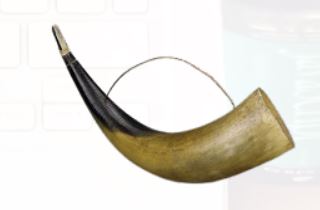
5.Dhamsa: Rhythms in the Breeze
Venture to the hills of Himachal Pradesh, and the Dhamsa will greet you with its rhythmic melodies. As the musician breathes life into this mouth-blown drum, the Dhamsa produces beats that mirror the pulse of nature. Each blow is a burst of rhythm that captures the heartbeat of the mountains.Dhamsa is used in Chhau dance to create scenes like war or militry parade.
6.Thala: Percussive Poetry
Picture the Thala—a percussion instrument—resounding through the streets of Rajasthan. This hand-held drum is brought to life by mouth-blowing, unleashing percussive poetry that resonates with celebrations and festivities. With each breath, the Thala becomes a burst of rhythm, infusing gatherings with joyous energy.
7.Shehnai: Song of Celebrations
In the grand tapestry of Indian weddings and festivals, the Shehnai takes the spotlight.
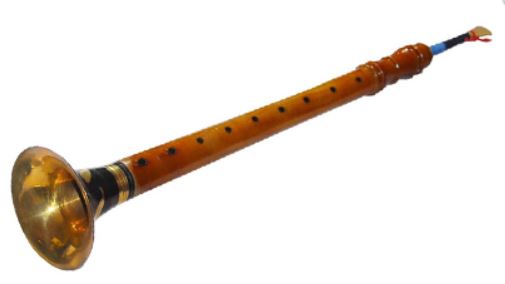
As breath flows through its tubes, this double-reed instrument bursts forth with melodies that announce celebrations. The Shehnai’s mouth-blown music becomes a burst of joy, uniting people in shared moments of happiness.Chhau, Paika,Natua dance Shennai is main musical instruments.
8.Madanbheri: Echoes of the Past
Travel to the Himalayan foothills, and you’ll discover the Madanbheri—a resonating brass horn. The musician’s breath, channeled through the mouthpiece, transforms into bursts of deep, resonant tones. The Madanbheri’s music transports listeners through time, invoking echoes of ancient rituals and traditions.In Jharkhand during wedding ceremonie this is played with Mandar, Nagara for dancing.
A Personal Note: Breath as Music’s Soul
Imagine holding these instruments close, feeling their vibrations resonate with your breath. The act of mouth-blowing isn’t just a technique—it’s an intimate connection between your life force and the creation of sound. Each note bursts forth as a result of your breath’s dance with the instrument, and together, you become a part of the music’s story.
As we explore Bansuri, Murali, Kenndri, Singa, Dhamsa, Thala, Shehnai, and Madanbheri, we realize that the essence they embody isn’t just about melodies—it’s about the synergy between breath, musician, and instrument. It’s about the fusion of human spirit and creative expression.
In a world where technology often takes center stage, these instruments remind us of the raw beauty of our breath as a creative force. They invite us to burst forth with music that originates from the very essence of our existence—a reminder that music isn’t just an art; it’s a burst of life itself.
Harmonizing Through Breath: The Unspoken Symphony
Through the act of mouth-blowing, these instruments transform into vessels of human expression. The breath that animates them carries stories, emotions, and cultures. With each exhale, they offer melodies that connect us to our past, present, and future. The Bansuri, Murali, Kenndri, Singa, Dhamsa, Thala, Shehnai, and Madanbheri collectively embody the universal language of music—an ode to the power of breath and the bursts of emotion it can evoke.
Section 4: Rhythmic Heartbeats: The Percussive Ensemble
Instruments that bestow rhythmic vitality to compositions frequently align with the beat. Jhal, Kartal, Thal, Bell, Ghungroo, Manjira, and the enigmatic Secoe, they all unite under the banner of “Percussion Instruments.” These instruments, with their diverse percussive identities, contribute the heartbeat to musical ensembles, punctuating melodies with their intricate cadences.
Amidst the myriad forms of musical expression, these instruments collectively create a symphony of diverse sounds, echoing through the annals of culture and time.
Rhythmic Reverberations: Embarking on a Percussive Odyssey with Musical Instruments
Within the realm of music, a captivating ensemble of instruments beckons—a symphony of sound shaped by the hands that beat, strike, and resonate with rhythm. These instruments, often played in sync with the heartbeat of time, form a distinct category known as “Percussion Instruments.” Picture the artistry of Jhal, Kartal, Thal, Bell, Ghungroo, Manjira, and Secoe—a collection of rhythmic storytellers that burst forth with melodies that awaken our senses and stir our souls.
1.Jhal: Tapping into Tradition
In the heart of cultural expressions, the Jhal commands attention as a percussive marvel.
The hands’ skilled taps upon its surface release bursts of rhythm that echo traditions and tales. As beats resound, the Jhal weaves an auditory tapestry that bridges past and present, cultural landscapes interwoven through percussive artistry.
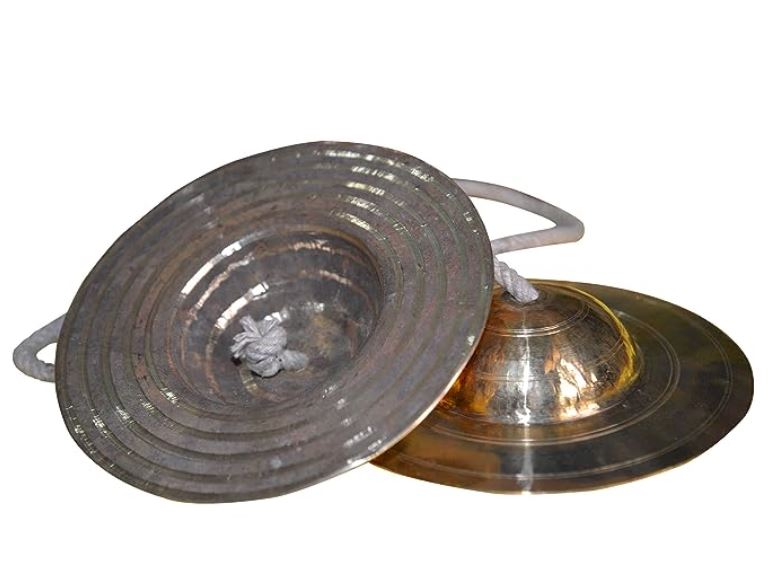
2.Kartal: Uniting Hands in Harmony
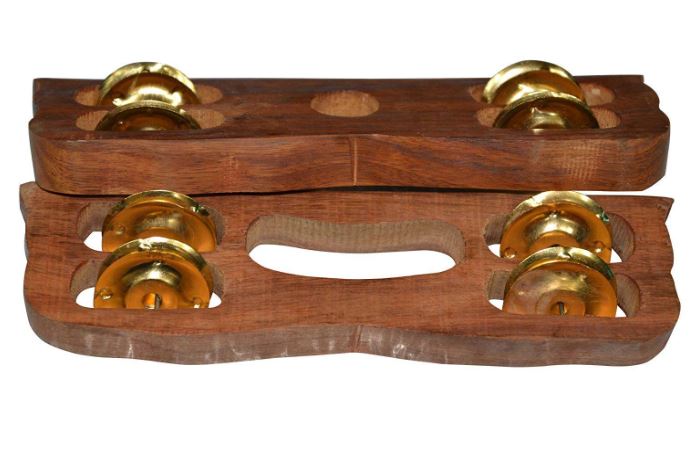
Imagine the Kartal, a percussive gem often found in devotional contexts. As hands clap these wooden castanets together, they create bursts of rhythm that resonate like a communal heartbeat. The Kartal’s sound becomes an instrument of unity, harmonizing hands and voices in a melodious embrace.
3.Thal: The Language of Beats
Travel to North India, and the Thal captures attention with its rhythmic repertoire. This percussive plate becomes a canvas for beats that communicate tales, emotions, and celebrations. With each strike, the Thal becomes a burst of language—a rhythmic conversation that traverses the boundaries of words.
4.Bell: Resonance of Announcements
In places of worship and ceremonies, the Bell rings out with resounding purpose. Its metallic surface, when struck, releases bursts of sound that mark moments of significance. The Bell’s chimes become a burst of announcement—a call to attention that resonates with the spiritual and the sacred.
5.Ghungroo: Footsteps of Melody
Ghungroos are Instrument in India. Ghungroos are generally the little metal ringers. It is a melodic extra utilized by entertainers of every single old style dance. Number of ringers are joined to a string or attached to a cotton line, velvet cushion or calfskin tie to shape a ghungroo. These ringers are made of metal and have little iron balls inside which add a considerable amount of weight to them.
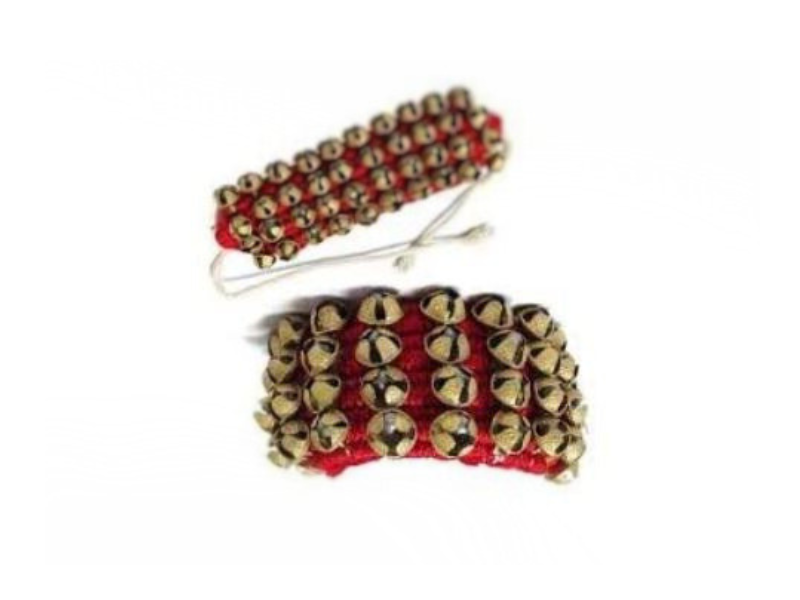
When attached to the feet, Ghungroos underscore the musical parts of the dance and permit complex footwork to be heard by the crowd. Ghungroo—tiny bells adorning dancers’ anklets, creating a harmonious melody with every step. As feet move, these percussive gems become a burst of musical expression, transforming movements into rhythms that intertwine with the dance’s narrative.
6.Manjira: A Lyrical Ensemble
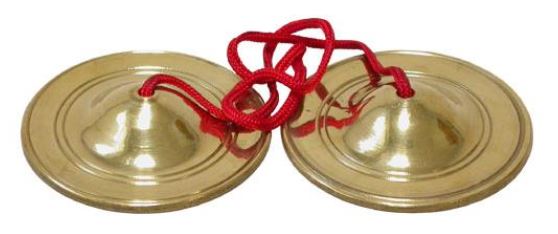
Manjira are generally made of bronze, metal, copper zinc or Chime metal and associated with a copper line which goes through openings in their middle. They produce a musical tinkling sound when struck together. The sound’s pitch fluctuates as per their size, weight and the material of their development. A player can likewise change the tone by fluctuating the resource while playing.
As hands clasp and release these small cymbals, they produce bursts of delicate chimes that invite participants into a melodic communion. The Manjira’s notes become a burst of devotion—a harmonious offering to the divine.
7.Secoe: Pulsating with Energy
Travel to West Africa, and the Secoe commands attention as a wooden idiophone. With swift movements, hands strike its resonators, releasing bursts of energetic beats. The Secoe’s percussive language becomes a burst of vitality, uniting people in the shared language of rhythm.
A Personal Note: Conversations of Sound
Imagine yourself amidst these instruments, feeling the vibrations as they respond to your touch. Each strike, each beat is a tactile dialogue—an interaction that isn’t just about creating sound. It’s about engaging with the very essence of rhythm, experiencing the burst of connection between musician, instrument, and listener.
Percussion instruments transcend mere sound; they become conduits for the human heartbeat’s expression. Their bursts of rhythm aren’t just notes—they’re stories, emotions, and memories encapsulated in beats. They’re the language of celebration, the cadence of devotion, and the harmony of unity.
As we explore the artistry of Jhal, Kartal, Thal, Bell, Ghungroo, Manjira, and Secoe, we recognize that these instruments bridge gaps between cultures, languages, and traditions. Their bursts of rhythm are an invitation to engage in a universal conversation—one that connects us to our heritage and to each other.
Harmonizing with Percussion: The Melodic Pulse
Amidst the beats of Jhal, Kartal, Thal, Bell, Ghungroo, Manjira, and Secoe, a symphony of humanity emerges. These percussive instruments don’t merely create melodies; they generate bursts of life, energy, and emotion. The hands that strike, the rhythms that resonate—they all come together to create an intricate tapestry of sound.
Jhal’s traditions, Kartal’s unity, Thal’s language, Bell’s announcements, Ghungroo’s dance, Manjira’s devotion, and Secoe’s vitality—all weave together a diverse spectrum of bursts that celebrate the richness of human expression. These instruments remind us that rhythm isn’t just a sequence of beats—it’s a burst of connection that unites us through the language of sound.
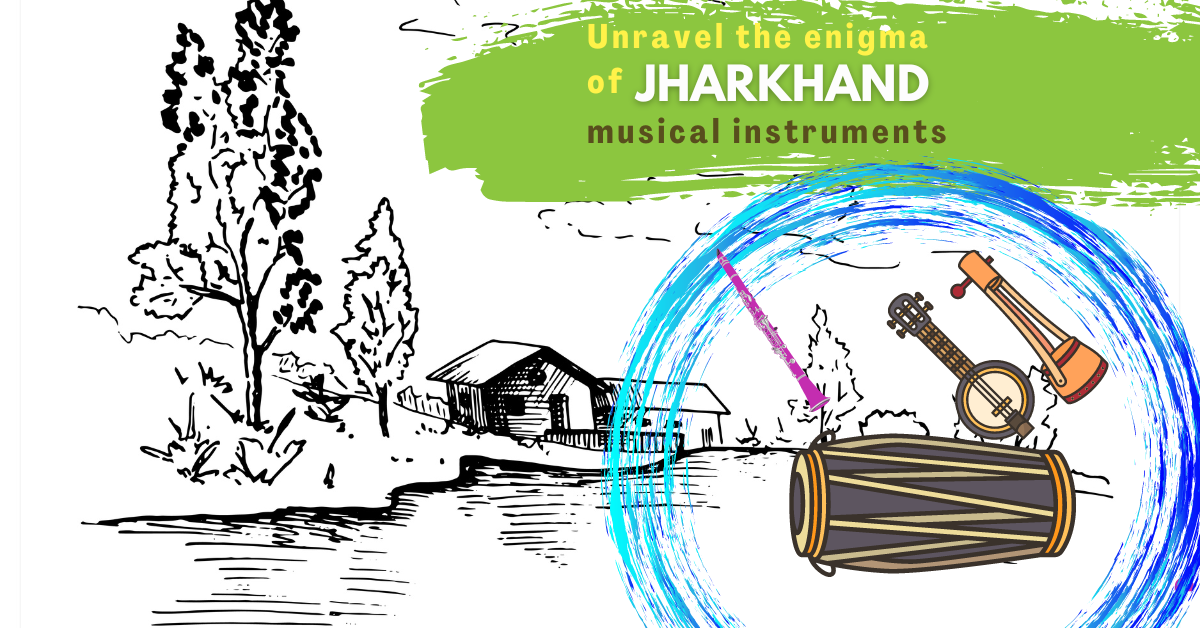
Does your website have a contact page? I’m having a tough time locating it but, I’d like to shoot you an email. I’ve got some suggestions for your blog you might be interested in hearing. Either way, great site and I look forward to seeing it expand over time.|
Please feel free to contact us at; contact@traditionsandcultures.com
I was suggested this web site by my cousin Im not sure whether this post is written by him as no one else know such detailed about my trouble You are incredible Thanks
Thank you for your comment! I’m glad to hear that you were suggested this website by your cousin. This post was written by me, I’m delighted that it provided detailed information about your trouble. Your kind words mean a lot, and I’m grateful for your appreciation. Thanks again for your support!
Wonderful web site Lots of useful info here Im sending it to a few friends ans additionally sharing in delicious And obviously thanks to your effort
You made a few good points there. I did a search on the topic and found nearly all persons will consent with your blog.
I have not checked in here for some time as I thought it was getting boring, but the last few posts are great quality so I guess I?¦ll add you back to my everyday bloglist. You deserve it my friend 🙂
Hiya, I am really glad I’ve found this info. Nowadays bloggers publish only about gossips and web and this is actually irritating. A good blog with exciting content, that’s what I need. Thank you for keeping this web site, I will be visiting it. Do you do newsletters? Cant find it.
But wanna remark that you have a very decent site, I love the design it actually stands out.
That is the correct blog for anybody who needs to find out about this topic. You understand a lot its almost onerous to argue with you (not that I truly would want…HaHa). You undoubtedly put a brand new spin on a topic thats been written about for years. Nice stuff, just nice!
Good post and right to the point. I don’t know if this is in fact the best place to ask but do you people have any ideea where to employ some professional writers? Thx 🙂
I am impressed with this website , very I am a big fan .
Hey! This is my first visit to your blog! We are a team of volunteers and starting a new initiative in a community in the same niche. Your blog provided us useful information to work on. You have done a wonderful job!
I do not even know how I ended up here but I thought this post was great I do not know who you are but certainly youre going to a famous blogger if you are not already Cheers
Thank you for another great post. Where else could anybody get that type of info in such a perfect way of writing? I have a presentation next week, and I am on the look for such info.
I precisely needed to thank you very much once more. I’m not certain the things I would have made to happen in the absence of the type of tricks contributed by you on such a concern. It has been a real terrifying concern for me personally, but finding out the very expert fashion you solved the issue made me to jump over delight. Now i am thankful for your service and as well , wish you recognize what a great job you are putting in training the rest using your blog post. Probably you’ve never encountered any of us.
It’s a shame you don’t have a donate button! I’d definitely donate to this superb blog! I guess for now i’ll settle for book-marking and adding your RSS feed to my Google account. I look forward to fresh updates and will share this site with my Facebook group. Talk soon!
I was looking through some of your content on this internet site and I believe this website is really instructive!
Keep on putting up.Expand blog
I am often to blogging and i really appreciate your content. The article has really peaks my interest. I am going to bookmark your site and keep checking for new information.
You made some clear points there. I looked on the internet for the subject and found most individuals will go along with with your site.
Everything is very open and very clear explanation of issues. was truly information. Your website is very useful. Thanks for sharing.
My brother suggested I might like this blog He was totally right This post actually made my day You can not imagine simply how much time I had spent for this info Thanks
I like this post, enjoyed this one regards for putting up.
I like this web site its a master peace ! Glad I discovered this on google .
Noodlemagazine I am truly thankful to the owner of this web site who has shared this fantastic piece of writing at at this place.
Very interesting points you have noted, thanks for posting. “The judge is condemned when the criminal is absolved.” by Publilius Syrus.
Thank you for sharing superb informations. Your web site is so cool. I am impressed by the details that you have on this website. It reveals how nicely you understand this subject. Bookmarked this website page, will come back for extra articles. You, my pal, ROCK! I found simply the information I already searched everywhere and just couldn’t come across. What a perfect web-site.
Usually I do not read post on blogs, however I wish to say that this write-up very pressured me to take a look at and do so! Your writing taste has been amazed me. Thank you, very nice article.